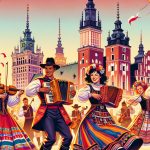
In Poland, parents can choose from several early childhood education options for their kids. These include public kindergartens, Montessori and Waldorf schools, private preschools, and even homeschooling.
Each choice offers a different way of learning and teaching, designed to meet various needs and preferences of both parents and kids. This article takes a closer look at what each of these options brings to the table. We’ll talk about their teaching styles, what kids learn, and how this might affect their growth.
By understanding the differences, families in Poland can better decide which path is right for their young learners. Let’s dive into these options and see how they help Polish families and their children.
Public Kindergartens
In Poland, public kindergartens play a crucial role in the early stages of a child’s education. They cater to kids from 3 to 6 years old, providing a well-organized space for them to start learning and interacting socially. The government sets the education standards for these kindergartens, ensuring they cover all areas of a child’s growth—be it physical, emotional, or intellectual. The idea is to make learning fun and engaging, helping children to become curious, creative, and cooperative. For example, the activities might include storytelling to boost language skills, simple puzzles to introduce basic math concepts, or nature walks to spark an interest in the environment.
Making sure every child can attend kindergarten, the government has policies to make these institutions accessible and welcoming to everyone. This inclusivity is important because it means no child is left behind, giving every child a fair start in education. This approach is not just about learning ABCs and 123s; it’s about preparing kids to adapt and grow in a world that’s always changing.
In a nutshell, public kindergartens in Poland are more than just a stepping stone in education. They’re a place where young minds begin to explore and understand the world around them. Through a mix of play and structured activities, children learn important life skills and knowledge, setting a strong foundation for their future learning journeys.
Private Preschools
Private preschools in Poland present a unique option for early childhood education that differs significantly from what public kindergartens offer. They provide a variety of programs designed to meet the specific learning preferences and needs of each child. One major advantage of these institutions is their smaller class sizes. This means teachers can give more attention to each student, making it easier for them to cater to individual learning styles and needs. Such an environment not only helps in recognizing and developing each child’s unique skills but also promotes a sense of belonging and community among students.
Moreover, it’s common for private preschools in Poland to offer programs in two or more languages. Starting language learning early can be a huge advantage, and these schools aim to make the most of this critical learning period. For example, a child might be exposed to English and French, in addition to their native Polish, from a very young age. This early start can set the foundation for fluency in multiple languages, a skill that’s increasingly valuable in our globalized world.
These preschools often embrace new teaching methods and technologies. They might use interactive apps or games that make learning fun and engaging. For instance, a preschool could use a storytelling app that allows children to create their own stories in different languages, combining language learning with creativity and technology.
Furthermore, the holistic approach adopted by private preschools in Poland ensures that children are well-prepared for the next stages of their education. Beyond academic skills, children learn to navigate social situations, understand and manage their emotions, and work well with others. This comprehensive preparation is crucial for their overall development and future success in school and beyond.
In essence, private preschools in Poland are about offering a tailored, engaging, and comprehensive educational experience from an early age. By focusing on smaller class sizes, multilingual education, innovative teaching methods, and a holistic approach to development, these schools aim to equip children with the skills they need for a bright future.
Montessori Schools
In Poland, Montessori schools take a unique route in teaching young kids. This method, created by Dr. Maria Montessori, puts the child at the center of learning. It’s all about letting kids learn through doing things themselves and working with others. They get to choose what they want to work on, which helps them become independent and eager to learn more. Imagine a classroom where kids of different ages learn together. This setup encourages the older ones to help the younger ones, making the learning experience richer for everyone.
Teachers in Montessori schools act more like mentors. Instead of just giving out information, they guide each child through their learning journey. This way, kids discover new things by exploring on their own. This method is gaining fans in Poland as more parents look for education options that respect their child’s unique way of learning and natural curiosity.
Montessori schools stand out because they focus on all aspects of a child’s growth. This includes their mind, body, and how they get along with others. The classrooms are designed with care, filled with educational materials that cater to various interests and learning stages. This environment makes learning enjoyable and relevant.
For example, in a Montessori classroom, you might see a child working on a math puzzle, while another practices writing with special tools that help improve their grip. This hands-on approach not only makes learning fun but also meaningful, as kids apply what they learn in real-world situations.
The popularity of Montessori education in Poland reflects a broader trend. Today, many people value education that fosters creativity, critical thinking, and the ability to adapt. This approach prepares children not just for the next grade, but for life. It’s a compelling option for parents who want their children to develop a lifelong love of learning and the skills to thrive in a changing world.
Waldorf Education
Waldorf education stands out as a unique approach to early childhood education, focusing on nurturing the whole child. This method, inspired by Rudolf Steiner, combines intellectual, artistic, and practical skills in a balanced manner. In Poland, for example, Waldorf schools craft their curriculum around the arts, humanities, and sciences. This blend encourages children to embrace learning and creativity from an early age.
What sets Waldorf education apart from traditional schooling is its emphasis on meeting the individual needs and talents of each child. This approach creates a supportive and inclusive environment. Children engage in storytelling, play, music, and hands-on activities, which helps them to connect with their environment and develop a well-rounded perspective on the world. This preparation goes beyond academics, aiming to equip children with the social and emotional tools they need for the future.
Let’s take a closer look at how this works in practice. In a Waldorf classroom, you might find students working on an art project, exploring nature, or engaged in a group discussion about a story they’ve just heard. These activities are not random; they are carefully chosen to stimulate different areas of development. For example, storytelling enhances language skills and imagination, while hands-on activities improve motor skills and foster problem-solving abilities.
The beauty of Waldorf education lies in its ability to adapt to the changing needs of children as they grow. Rather than sticking to a rigid curriculum, teachers observe and respond to the interests and developmental stages of their students. This responsive approach ensures that learning is always relevant and engaging.
Home Education Options
In Poland, parents looking for a different educational path for their children have the option of homeschooling. This method is fully supported and regulated by the country’s Ministry of National Education. To homeschool, parents need to apply with their local education authority and follow the national curriculum standards closely. Every year, homeschooled children must pass an exam to move up to the next grade level, ensuring they keep up with their peers in traditional schools.
The support for homeschooling families in Poland is growing. There are various resources and networks available to help with curriculum planning, teaching strategies, and finding ways for children to socialize. For example, online forums and local homeschooling groups can provide valuable advice and share experiences on effective teaching methods. Educational platforms like Khan Academy or Coursera offer structured courses across different subjects that align with the national curriculum, making it easier for parents to find quality materials.
Moreover, socialization opportunities are essential for homeschooled children. Joining sports teams, arts classes, or local community groups can help them make friends and develop social skills. These activities not only complement their academic learning but also ensure they have a well-rounded education.
Conclusion
Poland has a variety of options for early childhood education, so families can find what works best for them. You can choose from public kindergartens, which are open to everyone, or private preschools that might have a special focus or curriculum.
If you’re interested in a more individual approach to learning, Montessori schools could be a great fit. On the other hand, Waldorf schools focus more on the whole development of a child.
And if you prefer to keep things flexible, homeschooling allows you to tailor the learning experience to your child’s needs. Each of these choices comes with its own way of teaching kids, highlighting the importance of having options in early childhood education in Poland.






Comments are closed.